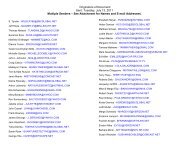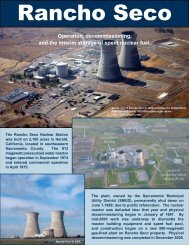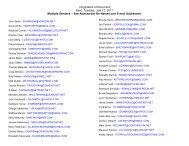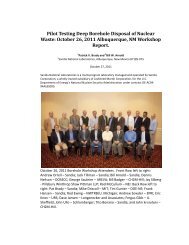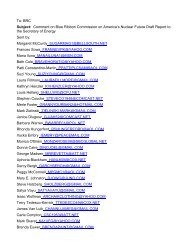Parametric Study of Front-End Nuclear Fuel Cycle Costs Using ...
Parametric Study of Front-End Nuclear Fuel Cycle Costs Using ...
Parametric Study of Front-End Nuclear Fuel Cycle Costs Using ...
Create successful ePaper yourself
Turn your PDF publications into a flip-book with our unique Google optimized e-Paper software.
Impact <strong>of</strong> Changes in <strong>Front</strong>-<strong>End</strong> <strong>Fuel</strong> <strong>Cycle</strong> Unit <strong>Costs</strong> on Overall <strong>Fuel</strong> <strong>Cycle</strong> Cost<br />
10<br />
9<br />
8<br />
NatU $90<br />
NatU $60<br />
7<br />
<strong>Fuel</strong> <strong>Cycle</strong> Cost (mills/kwhe)<br />
6<br />
5<br />
4<br />
3<br />
RepU<br />
NatU $30<br />
2<br />
1<br />
0<br />
$90 $120 $150 $180 $210<br />
NatU Enrichment Unit Cost ($/SWU)<br />
NatU $30 NatU $60 NatU $90 RepU - Enr +30%<br />
Figure 3-8<br />
Comparison <strong>of</strong> <strong>Front</strong>-<strong>End</strong> <strong>Fuel</strong> <strong>Cycle</strong> Cost for NatU LWR <strong>Fuel</strong> and RepU LWR <strong>Fuel</strong> as a<br />
Function <strong>of</strong> Uranium Ore Concentrate and Enrichment Services Unit <strong>Costs</strong><br />
3.10 Conclusions<br />
Under the range <strong>of</strong> unit costs evaluated in this report, uranium ore concentrates and uranium<br />
enrichment services represent almost 90% <strong>of</strong> overall nuclear fuel cycle costs for fuel cycles that<br />
utilize natural uranium. In contrast, for reload fuel that utilizes RepU, the uranium feedstock has<br />
zero cost and uranium enrichment services represent approximately 77% <strong>of</strong> the front-end fuel<br />
cycle costs. While the costs to process RepU (conversion, enrichment and fuel fabrication) are<br />
higher than that for LWR fuel utilizing NatU, displacing NatU with RepU may represent<br />
substantial front-end fuel cost savings depending upon the unit price <strong>of</strong> uranium concentrates.<br />
As shown in Table 2-1, at the nominal front-end unit costs utilized by EPRI in this study, reload<br />
fuel cycle costs for a typical PWR are lower for RepU than for NatU at nominal unit costs <strong>of</strong><br />
$48/lb U 3<br />
O 8<br />
. As shown in Figure 3-1, assuming all other fuel cycle costs are set at the nominal<br />
values, when the unit cost <strong>of</strong> uranium ore concentrates rises above approximately $35/lb U 3<br />
O 8<br />
,<br />
there may be a cost benefit associated with recycling RepU in the place <strong>of</strong> NatU.<br />
As shown in Section 3.2 and 3.3, EPRI examines not only the impact <strong>of</strong> changing the unit costs<br />
associated with conversion services and enrichment services, but also the impact <strong>of</strong> increasing<br />
the “premium” (that is the additional cost) associated with processing RepU. As the premium<br />
associated with processing RepU increases for either conversion or enrichment services, the cost<br />
3-13


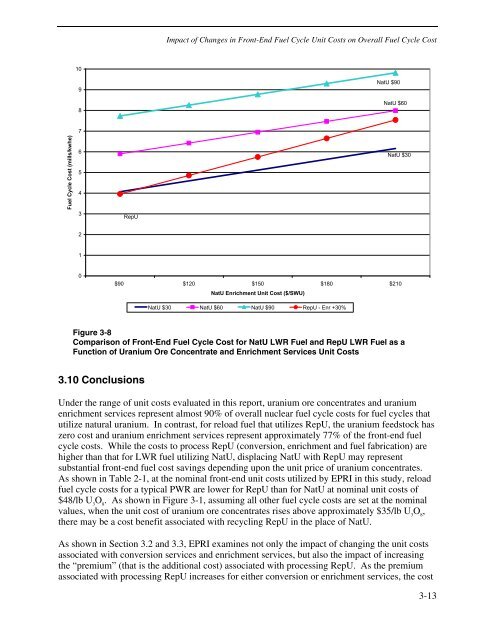
![Rainer Schottlaender[SMTP:RAINER.SCHOTTLAENDER@WEB.DE]](https://img.yumpu.com/51418350/1/190x245/rainer-schottlaendersmtprainerschottlaenderwebde.jpg?quality=85)
